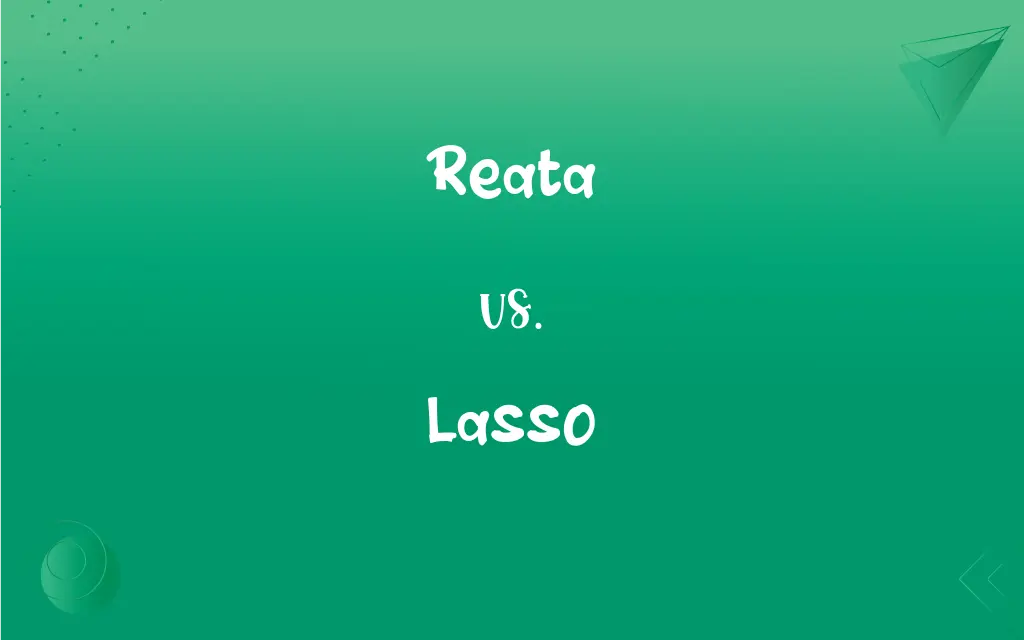Reata vs. Lasso: What's the Difference?
By Harlon Moss & Janet White || Updated on May 23, 2024
A reata is a long, braided rope traditionally used by Mexican cowboys, while a lasso is a rope with a loop at one end used primarily in North American rodeo events for catching livestock.

Key Differences
A reata is a type of rope, often made from rawhide or leather, traditionally used by Mexican cowboys, also known as vaqueros. It is typically long and braided, designed for durability and flexibility in handling livestock. A lasso, on the other hand, is a rope with a loop at one end, commonly used by cowboys in North America. It is mainly utilized in rodeo events and cattle ranching for catching animals.
The reata's craftsmanship reflects its cultural heritage, often featuring intricate braiding and strong construction. This tool is integral to traditional Mexican horsemanship and cattle work. In contrast, the lasso is more standardized, focusing on functionality for roping and controlling cattle in a rodeo setting.
While both tools serve similar purposes in livestock management, the reata is more specific to Mexican traditions, whereas the lasso is a staple in American cowboy culture. Each term highlights different regional practices and styles in handling and controlling cattle.
Comparison Chart
Origin
Mexican vaquero tradition
North American cowboy culture
Material
Rawhide or leather
Nylon, hemp, or polyester
ADVERTISEMENT
Design
Long, braided rope
Rope with a loop at one end
Primary Use
Livestock handling
Roping in rodeo events
Cultural Significance
Integral to Mexican horsemanship
Iconic in American rodeo practices
Reata and Lasso Definitions
Reata
A long, braided rope traditionally used by Mexican cowboys.
The vaquero skillfully used his reata to catch the stray calf.
Lasso
A tool for roping cattle in rodeo events.
She practiced her lasso skills for the upcoming rodeo.
ADVERTISEMENT
Reata
An intricately braided rope reflecting Mexican craftsmanship.
The reata's braiding was a testament to the artisan's skill.
Lasso
A rope with a loop at one end used to catch animals.
The cowboy expertly threw his lasso around the bull's neck.
Reata
A Mexican cowboy's essential equipment.
He always carried his reata when working on the ranch.
Lasso
A rope used in North American cowboy culture.
The lasso was a key part of his ranching gear.
Reata
A durable rope made from rawhide or leather.
The reata hung from the saddle, ready for use.
Lasso
A rope designed to capture and control livestock.
The lasso's loop tightened around the horse.
Reata
A tool for managing livestock in Mexican traditions.
His reata was essential for rounding up the cattle.
Lasso
A versatile rope made from various materials like nylon.
He preferred a nylon lasso for its durability and strength.
Reata
Variant of riata.
Lasso
A long rope with a running noose at one end, used especially to catch horses and cattle. Also called lariat.
Reata
A lariat or lasso.
Lasso
To catch, tie, or attach with or as if with a lasso.
Reata
A lariat.
Lasso
A long rope with a sliding loop on one end, generally used in ranching to catch cattle and horses.
Reata
A long noosed rope used to catch animals
Lasso
(computing) An image-editing function allowing the user to capture an irregularly-shaped object by drawing an approximate outline.
Lasso
(transitive) To catch with a lasso.
Lasso
A rope or long thong of leather with a running noose, used for catching horses, cattle, etc.
Lasso
To catch with a lasso.
Lasso
Belgian composer (1532-1594)
Lasso
A long noosed rope used to catch animals
Lasso
Catch with a lasso;
Rope cows
FAQs
What is a lasso?
A lasso is a rope with a loop at one end, used primarily in North American rodeos to catch animals.
How is a reata made?
A reata is typically made from rawhide or leather, intricately braided for strength and flexibility.
What cultural significance does a reata hold?
A reata is integral to Mexican horsemanship and reflects the craftsmanship and traditions of the vaqueros.
How is a lasso different in construction from a reata?
A lasso can be made from various materials such as nylon, hemp, or polyester, and features a loop at one end.
Are there different types of lassos?
Yes, lassos can vary in material and length depending on their specific use.
What skills are required to use a reata?
Using a reata requires skilled handling, knowledge of livestock, and expertise in roping techniques.
What is a reata?
A reata is a long, braided rope used by Mexican cowboys for handling livestock.
Is the reata still used today?
Yes, the reata is still used in traditional Mexican cattle ranching and horsemanship.
Is the lasso still used today?
Yes, the lasso is widely used in rodeos and cattle ranching.
What events commonly use a lasso?
A lasso is commonly used in rodeo events and cattle ranching in North America.
Can a reata be used in rodeos?
While a reata can be used in similar ways, it is more traditional to Mexican cowboy culture.
Which term is more associated with Mexican culture?
Reata is more associated with Mexican culture and traditions.
Are reatas used in modern competitions?
Reatas can be used in traditional Mexican charreada events, similar to rodeos.
Which term is more commonly known in the US?
Lasso is more commonly known in the US due to its association with American cowboy culture.
What is a common material for modern lassos?
Modern lassos are often made from nylon for durability and ease of use.
Which is typically longer, a reata or a lasso?
Reatas are often longer due to their traditional use in open range cattle work.
What is a historical material for reatas?
Historically, reatas are made from rawhide or leather.
Do reatas have a loop like lassos?
Reatas do not typically have a fixed loop like lassos; they are used differently.
What skills are required to use a lasso?
Using a lasso involves precision, timing, and practice, especially in rodeo contexts.
Can a lasso be used for purposes other than roping cattle?
Yes, lassos can be used for various purposes, including training and recreational activities.
About Author
Written by
Harlon MossHarlon is a seasoned quality moderator and accomplished content writer for Difference Wiki. An alumnus of the prestigious University of California, he earned his degree in Computer Science. Leveraging his academic background, Harlon brings a meticulous and informed perspective to his work, ensuring content accuracy and excellence.
Co-written by
Janet WhiteJanet White has been an esteemed writer and blogger for Difference Wiki. Holding a Master's degree in Science and Medical Journalism from the prestigious Boston University, she has consistently demonstrated her expertise and passion for her field. When she's not immersed in her work, Janet relishes her time exercising, delving into a good book, and cherishing moments with friends and family.































































